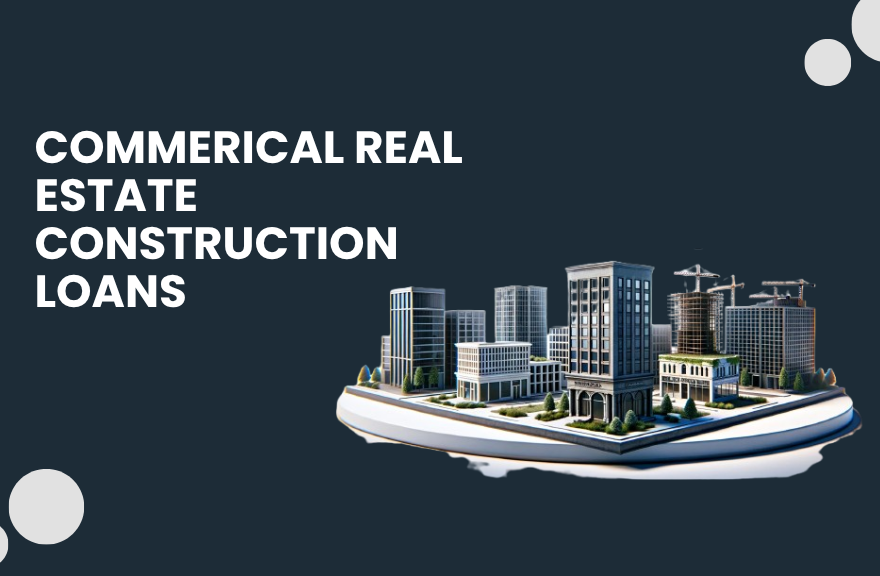Navigating the world of commercial real estate construction loan can feel overwhelming for both new and experienced investors. Understanding how these loans work is essential to securing the capital necessary to bring your vision to life. These loans are specifically designed to finance the construction, renovation, or expansion of commercial properties including office buildings, shopping centers, apartment complexes, and warehouses.
Whether you are building a new property from scratch or renovating an existing one, knowing the nuances of construction financing allows you to make informed decisions and avoid common mistakes. Construction loans provide a structured approach to funding projects that require significant upfront capital. This guide will walk you through everything you need to know about these loans, including how they operate, the different types available, qualification criteria, practical tips to improve approval chances, and common challenges to be aware of.
What is a Commercial Real Estate Construction Loan?
A commercial real estate construction loan is a short-term financing solution intended to fund the building or major renovation of commercial properties. Unlike traditional mortgages that provide a lump sum upfront, construction loans release funds in phases as work progresses. This phased approach is also called a draw-based system, and it ensures that lenders can minimize risk while borrowers access capital as needed.
These loans generally last between 12 and 36 months. During construction, borrowers often make interest-only payments, which helps reduce the monthly financial burden while work is ongoing. The funds are released in stages, known as draws, corresponding to specific milestones such as foundation completion, framing, and finishing. Once the project is complete, the loan can either be refinanced, converted into a permanent mortgage, or paid off in full.
Construction loans are commonly used by developers who need significant funding but do not have the full amount available upfront. This type of financing allows developers to manage cash flow, maintain progress according to the project schedule, and ensure that funds are allocated properly.
How Draw-Based Financing Works
Construction loans operate differently from traditional mortgages because of their phased fund release system. Instead of receiving the entire loan amount at once, borrowers receive portions of the capital as each construction milestone is completed. This approach ensures money is used appropriately and reduces risk for both lenders and borrowers.
The process begins with submitting a detailed project plan, including architectural designs, construction budgets, timelines, and financial statements. Lenders review these documents to evaluate the feasibility of the project and the borrower’s financial stability. Once approved, borrowers receive a loan agreement that outlines the interest rate, repayment schedule, and the plan for releasing funds.
As construction progresses, inspections occur at each milestone. The next portion of funds is released only after verification that the stage has been completed according to plan. Interest is generally charged only on the funds that have been drawn, which helps maintain manageable cash flow. After the property is finished, the loan may be converted into long-term financing, refinanced, or paid off, depending on the borrower’s strategy. This structure protects both parties and ensures that funds are not misused.
Different Types of Construction Loans
The type of commercial real estate construction loan selected depends on the project size, scope, and financial strategy. Ground-up construction loans are suitable for projects built from scratch and usually cover the cost of land acquisition, permits, labor, materials, and other related expenses. Developers commonly use these loans for office buildings, retail centers, and industrial warehouses.
Renovation and expansion loans are designed for properties that require upgrades or additional space. These loans cover remodeling work, structural improvements, system upgrades, or expansion to increase functionality. They are ideal for businesses looking to modernize their operations or increase usable space for tenants or employees.
Mini-perm loans are short-term solutions used after construction ends but before long-term financing is secured. They act as a bridge loan during the lease-up phase, when the property may not yet be stabilized but is starting to generate income. This allows borrowers to secure immediate funding while waiting for long-term solutions.
Government-backed options such as SBA 504 and SBA 7(a) loans provide small business owners with affordable financing to build, expand, or renovate commercial properties. SBA loans generally offer lower interest rates, longer repayment terms, and smaller down payments compared to conventional financing. Choosing the right type of loan requires understanding your project timeline, budget, risk tolerance, and long-term financial goals.
Who Can Qualify for a Construction Loan
Lenders carefully evaluate applicants to ensure that the project is viable and the borrower is financially stable. Successful applicants generally provide a detailed business plan that includes cost breakdowns, architectural drawings, and construction schedules. A clear timeline showing construction milestones and proof of equity contribution, usually between 10 and 30 percent of the project cost, is also required.
A strong personal and business credit history is critical because it demonstrates the borrower’s ability to manage debt and repay the loan. Previous experience in real estate development is preferred but not always required. Presenting an organized, professional application with thorough documentation increases the likelihood of approval and indicates that the borrower is prepared to manage the project efficiently.
In addition to credit and equity, lenders may also consider the borrower’s business track record, management experience, and ability to handle unexpected challenges. The more evidence provided that shows reliability and competency, the higher the chance of securing favorable loan terms.
Understanding Interest Rates and Loan Terms
Interest rates for construction loans vary depending on credit history, project details, and current market conditions. These loans usually have higher rates than standard mortgages because of the inherent risk involved with construction projects.
Loan terms typically range from 12 to 36 months, and borrowers often make interest-only payments during construction to ease cash flow constraints. The loan-to-value ratio can go up to 80 percent, with the remaining funds coming from the borrower’s equity. Additional fees, including loan origination charges, inspection fees, and reserve requirements, are commonly added to the loan costs. Once the project is completed, many borrowers refinance or convert the construction loan into a long-term mortgage to reduce payments and secure better rates.
Understanding the terms and anticipating potential additional costs are essential to ensure the project remains within budget. It is important to carefully review all terms with your lender and consult financial advisors if needed.
Pros and Cons of Construction Financing
Construction loans provide developers access to substantial capital that allows them to complete projects that would not be possible with cash alone. The draw-based system ensures that funds are distributed according to progress, which reduces risk and prevents misuse. Interest-only payments during construction help maintain financial flexibility, and after completion, the loan can often be converted into permanent financing to facilitate long-term planning.
On the downside, construction loans generally carry higher interest rates and fees compared to traditional mortgages. The application process can be complex, requiring extensive documentation and a clear financial plan. Borrowers are also expected to contribute a significant equity amount, and unexpected construction delays or cost overruns can add financial pressure. Careful planning, budgeting, and contingency preparation are essential to minimize these risks.
Real-Life Example
Consider a developer in Atlanta planning a $7 million office complex. The developer invests $1.5 million of personal capital and applies for a $5.5 million construction loan. The lender agrees to fund the project in five stages: excavation, foundation, framing, finishing, and final inspection. Inspections occur at each stage, and the next draw is released only after verification that the work has been completed properly.
During the construction period, the developer pays interest only on the funds drawn so far. Once the building is fully leased, the construction loan is refinanced into a 20-year permanent mortgage, providing long-term financial stability and predictable payments. This approach demonstrates the benefits of structured financing and effective project management.
Steps to Apply for a Construction Loan
Applying for commercial real estate construction loan can seem complex, but breaking the process into steps makes it more manageable. First, gather all essential documents, including detailed construction plans, budget estimates, business and personal financial statements, credit reports, and proof of equity contribution. Preparing these materials in advance can save time and improve the quality of your application.
Next, research and select lenders experienced in commercial construction loans. Regional banks, credit unions, and private lenders may all provide suitable options. Work with lenders who have knowledge of your specific project type to ensure smoother communication and approval.
When submitting your application, include a cover letter that explains the purpose of the loan, project details, and why you are a reliable borrower. This helps the lender understand the scope and potential of your project.
After submission, the lender will conduct underwriting and property appraisal to evaluate the feasibility of the project. If approved, a loan agreement is issued and the first draw of funds is released. Maintaining open communication and staying on schedule is crucial for timely disbursement of subsequent draws.
Tips for Improving Your Chances of Approval
Maintaining a strong credit score demonstrates financial responsibility and reduces lender risk. Providing evidence of successful past projects helps prove your ability to manage construction efficiently. Transparency, organization, and professionalism throughout the process also build lender confidence.
Working with a skilled team of architects, contractors, and project managers is critical. Lenders are more confident when they know experienced professionals are overseeing the project. Planning for potential delays and including a contingency budget shows foresight and preparedness. These strategies collectively increase the likelihood of loan approval.
Common Challenges and How to Avoid Them
Construction projects often encounter unexpected costs. Setting aside a contingency fund of at least 10 to 15 percent of the budget can prevent financial stress when surprises occur. Permit delays are another common issue. Starting the permitting process early and maintaining regular communication with authorities can help avoid schedule disruptions.
Inspection delays can also impact the release of funds. Documenting milestones clearly ensures inspections occur on schedule. Market fluctuations, such as interest rate changes and property value shifts, may also affect the project. Conducting a detailed market analysis before construction can help anticipate risks and make informed decisions.
Conclusion
Commercial construction loans are essential tools for turning development plans into reality. They provide the necessary capital and flexibility to manage complex projects, whether building from scratch or renovating existing properties. By understanding how commercial real estate construction loan work, meeting lender requirements, and planning carefully, developers can navigate the financing process with confidence. Preparation, organization, and partnering with the right lender are key to project success.
Frequently Asked Questions
What is the difference between a construction loan and a commercial mortgage?
A commercial mortgage finances an already completed property long term. A construction loan funds the building process itself for a short term.
Can construction loans be used for renovations?
Yes, many lenders offer loans specifically for structural upgrades and space expansions.
How much equity is required?
Most lenders require borrowers to contribute between 10 and 30 percent of the project cost.
Are government-backed loans available?
Yes, SBA 504 and SBA 7(a) loans provide long-term, low-interest financing for eligible small businesses.
What happens if construction is delayed?
Delays may increase interest costs and overall project expenses. Communicate proactively with your lender and plan buffer time to avoid major issues.

Introducing Emily Parker, a seasoned professional with over 5 years of expertise in DSCR loans. With her extensive knowledge and experience in the field, Varsha has consistently demonstrated a deep understanding of DSCR loan intricacies and a proven track record of delivering successful outcomes for her clients.

